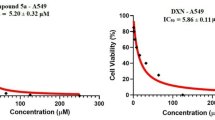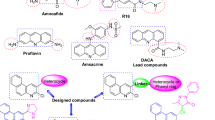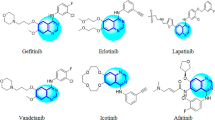Summary
Three lipophilic quinazoline-based aminomethyl pyridine compounds, which differ only in the position of the nitrogen in their pyridine ring, are described. CB300179 (2-pyridine), CB300189 (4-pyridine) and CB30865 (3-pyridine) all inhibited isolated mammalian TS with IC50 values of 508, 250 and 156 nM respectively. CB30865 was the most potent growth inhibitory agent (IC50 values in the range 1– 100 nM for several mouse and human cell types). CB300179 and CB300189 were active in the micromolar range. Against W1L2 cells, CB300179 and CB300189 demonstrated reduced potency in the presence of exogenous thymidine (dThd), and against a W1L2:C1 TS overproducing cell line. In contrast, CB30865 retained activity in these systems. Furthermore, combinations of precursors and end products of folate metabolism, e.g. dThd/hypoxanthine (HX) or leucovorin (LV), did not prevent activity. CB30865 did not interfere with the incorporation of tritiated dThd, uridine or leucine after 4 h. A cell line was raised with acquired resistance to CB30865 (W1L2:R865; > 200-fold), which was not cross-resistant to CB300179 or CB300189. In addition, W1L2:R865 cells were as sensitive as parental cells to agents from all the major chemotherapeutic drug classes. CB300179 and CB300189 induced an S phase accumulation (preventable by co-administration of dThd). No cell cycle redistribution was observed following exposure (4–48 h) to an equitoxic concentration of CB30865. In the NCI anticancer drug-discovery screen, CB30865 displayed a pattern of activity which was not consistent with known anti-tumour agents. These data suggest that CB30865 represents a class of potent potential anti-tumour agents with a novel mechanism of action.
Similar content being viewed by others
Article PDF
Change history
16 November 2011
This paper was modified 12 months after initial publication to switch to Creative Commons licence terms, as noted at publication
References
Bavetsias, V., Marriott, J. H., Melin, C., Kimbell, R., Boyle, F. T. & Jackman, A. L. (1997). Synthesis and antitumour activity of cyclopenta[g]quinazoline-based antifolates, a novel class of thymidylate synthase (TS) inhibitors. Br J Cancer 75(Suppl 1): 24
Boyd, M. R. (1989). Status of the NCI preclinical antitumor drug discovery screen: implications for selection of new agents for clinical trial. In Cancer: Principles and Practice of Oncology Updates, Vol. 3, De Vita VT, Hellman S and Rosenberg SA (eds), pp. 1–12. Lippincott: Philadelphia
Boyd, M. R., Paull, K. D. & Rubinstein, L. R. (1992). Data display and analysis strategies for the NCI disease-orientated in vitro antitumour drug screen. In Cytotoxic Anticancer Drugs: Models and Concepts for Drug Discovery and Development, Valeriote FA, Corbett T and Baker L (eds), pp. 11–34. Kluwer Academic Publishers: Amsterdam
Calvert, A. H., Jones, T. R., Jackman, A. L., Brown, S. J. & Harrap, K. R. (1980). An approach to the design of antimetabolites active against cells resistant to conventional agents illustrated by quinazoline antifolates with N10-substitutions. In Advances in Tumor Prevention, Detection and Characterisation, Vol. 5, Davis W, Harrap KR and Stathopoulos G (eds), pp. 272–283. Excepta Medica: Amsterdam
Charcosset, J. Y. (1986). Effects of antineoplastic agents on the cell cycle progression. Biol Cell 58: 135–138.
Hook, K. E., Nelson, J. M., Roberts, B. J., Griswold, D. P. & Leopold, W. R. (1986). Cell cycle effects of trimetrexate (CI-898). Cancer Chemother Pharmacol 16: 116–120.
Jackman, A. L., Calvert, A. H., Hart, L. I. & Harrap, K. R. (1984). Inhibition of thymidylate synthetase by the new quinazoline antifolate CB3717; enzyme purification and kinetics. In Purine Metabolism in Man IV, Part B: Biochemical, Immunological and Cancer Research, de Bruyn C, Simmonds H and Miller M (eds), pp. 375–378. Plenum Press: New York
Jackman, A. L., Alison, D. L., Calvert, A. H. & Harrap, K. R. (1986). Increased thymidylate synthase in L1210 cells possessing acquired resistance to N10-propargyl-5,8-dideazafolic acid (CB 3717): development, characterisation, and cross-resistance studies. Cancer Res 46: 2810–2815.
Jackman, A. L., Taylor, G. A., O’Connor, B. M., Bishop, J. A., Moran, R. G. & Calvert, A. H. (1990). Activity of the thymidylate synthase inhibitor 2-desamino-N10-propargyl-5,8-dideazafolic acid and related compounds in murine (L1210) and human (W1L2) systems in vitro and in L1210 in vivo. Cancer Res 50: 5212–5218.
Jackman, A. L., Newell, D. R., Gibson, W., Jodrell, D. I., Taylor, G. A., Bishop, J. A., Hughes, L. R. & Calvert, A. H. (1991). The biochemical pharmacology of the thymidylate synthase inhibitor, 2-desamino-2-methyl-N10-propargyl-5,8-dideazafolic acid (ICI 198583). Biochem Pharmacol 42: 1885–1895.
Jackman, A. L., Kelland, L. R., Kimbell, R., Brown, M., Gibson, W., Aherne, G. W. & Hardcastle, A., Boyle-FT (1995a). Mechanisms of acquired resistance to the quinazoline thymidylate synthase inhibitor ZD1694 (Tomudex) in one mouse and three human cell lines. Br J Cancer 71: 914–924.
Jackman, A. L., Kimbell, R., Brown, M., Brunton, L. & Boyle, F. T. (1995b). Quinazoline thymidylate synthase inhibitors: methods for assessing the contribution of polyglutamation to their in vitro activity. Anti-Cancer Drug Design 10: 555–572.
Jackman, A. L., Kimbell, R., Brown, M., Brunton, L., Harrap, K. R., Wardleworth, J. M. & Boyle, F. T. (1995c). The antitumour activity of ZD9331, a non-polyglutamatable quinazoline thymidylate synthase inhibitor. In Purine and Pyrimidine Metabolism in Man. Advances in Experimental Medicine and Biology, Vol. 370, Sahota A and Taylor M (eds), pp. 185–188. Plenum Press: New York
Jackman, A. L., Boyle, F. T. & Harrap, K. R. (1996a). TomudexTM (ZD1694): from concept to care, a programme in rational drug discovery. Invest New Drugs 14: 305–316.
Jackman, A. L., Skelton, L. A., Kimbell, R., Hughes, L. R. & Boyle, F. T. (1996b). Lipophilic quinazoline analogues of folic acid with 3-pyridylamide replacing the glutamate: evidence for a non-folate locus. Proc Amer Assoc Cancer Res 37: 394
Jackman, A. L., Kimbell, R., Aherne, G. W., Brunton, L., Jansen, G., Stephens, T. C., Smith, M. N., Wardleworth, J. M. & Boyle, F. T. (1997a). Cellular pharmacology and in vivo activity of a new anticancer agent, ZD9331: a water-soluble, nonpolyglutamatable, quinazoline-based inhibitor of thymidylate synthase. Clinical Cancer Res 3: 911–921.
Jackman, A. L., Kimbell, R., Melin, C., Boyle, F. T., Marriott, J. & Bavetsias, V. (1997b). Folate-based (acidic) thymidylate synthase (TS) inhibitors with activity independent of the reduced-folate carrier (RFC) and folylpolyglutamate synthetase (FPGS). Proc Amer Assoc Cancer Res 38: 162
Kobayashi, H., Takemura, Y., Miyachi, H., Skelton, L. A. & Jackman, A. L. (1995). Effect of hammerhead ribozyme against thymidylate synthase on the cytotoxicity of thymidylate synthase inhibitors. Jpn J Cancer Res 86: 1014–1018.
Lorico, A., Toffoli, G., Boiocchi, M., Erba, E., Broggini, M., Rappa, G. & D’Incalci, M. (1988). Accumulation of DNA strand breaks in cells exposed to methotrexate or N10-propargyl-5,8-dideazafolic acid. Cancer Res 48: 2036–2041.
Melin, C., Kimbell, R., Bavetsias, V., Marriott, J. H., Boyle, F. T. & Jackman, A. L. (1997). In vitro activity of the cyclopenta[g]quinazolines, a novel class of thymidylate synthase (TS) inhibitors. Br J Cancer 75(Suppl 1): 24
Monks, A., Scudiero, D., Skehan, P., Shoemaker, R., Paull, K., Vistica, D., Hose, C., Langley, J., Cronise, P., Vaigro-Wolff, A., Gray-Goodrich, M., Campbell, H., Mayo, J. & Boyd, M. (1991). Feasibility of a high-flux anticancer drug screen using a diverse panel of cultured human tumour cell lines. J Natl Cancer Inst 11: 757–776.
O’Connor, B. M., Jackman, A. L., Crossley, P. H., Freemantle, S. E. & Calvert, A. H. (1992). Human lymphoblastoid cells with acquired resistance to C2-desamino-C2-methyl-N10-propargyl-5,8-dideazafolic acid (ICI 198583); a novel folate-based TS inhibitor. Cancer Res 52: 1137–1143.
Ormerod, M. G. (1994). Analysis of DNA-general methods. In Flow Cytometry: A Practical Approach, 2nd edn, Ormerod MG (ed), pp. 118–135. Oxford University Press: New York
Paull, K. D., Shoemaker, R. H., Hodes, L., Monks, A., Scudiero, D. A., Rubinstein, L., Plowman, J. & Boyd, M. R. (1989). Display and analysis of patterns of differential activity of drugs against human tumour cell lines: development of mean graph and COMPARE algorithm. J Natl Cancer Inst 81: 1088–1092.
Skelton, L. A., Kimbell, R., Brunton, L., Boyle, F. T. & Jackman, A. L. (1994a). Lipophilic inhibitors of thymidylate synthase: 2-pyridyl quinazolines. Br J Cancer 69(Suppl XXI): 41
Skelton, L. A., Kimbell, R., Brunton, L. A., Boyle, F. T. & Jackman, A. L. (1994b). 2-Pyridyl quinazolines as inhibitors of thymidylate synthase. Proc Amer Assoc Cancer Res 35: 301
Skelton, L. A., Kimbell, R., Boyle, F. T. & Jackman, A. L. (1997). Aminomethyl pyridine analogues of the quinazoline antifolate ICI 198583 with a folate-independent locus of action. In Chemistry and Biology of Pteridines and Folates, Pfleiderer W and Rokos H (eds), pp. 209–212. Blackwell Science: Berlin
Skelton, L. A., Ormerod, M. G., Titley, J. & Jackman, A. L. (1998). Cell cycle effects of CB30865 – a lipophilic quinazoline-based analogue of the antifolate TS inhibitor, ICI 198583, with an undefined mechanism of action. Cytometry 33: 56–66.
Stephens, T. C., Smith, M. N., Waterman, S. E., McCloskey, M. L., Jackman, A. L. & Boyle, F. T. (1993). Use of murine L5178Y lymphoma thymidine kinase mutants for in vitro and in vivo antitumour efficacy evaluation of novel thymidylate synthase inhibitors. In Chemistry and Biology of Pteridines and Folates, Ayling J, Nair MG and Baugh CM (eds), pp. 589–582. Plenum Press: New York
Taylor, G. A., Jackman, A. L., Balmanno, K., Hughes, L. R. & Calvert, A. H. (1989). Estimation of the in vitro and in vivo inhibitory effect of antifolates upon thymidylate synthase (TS) in whole cells. In Purine and Pyrimidine Metabolism in Man VI, Part B, Mikanagi K, Nishioka K and Kelley WN (eds), pp. 383–388. Plenum: New York
Taylor, I. W. & Tattersall, M. N. H. (1981). Methotrexate cytotoxicity in cultured human leukaemic cells studied by flow cytometry. Cancer Res 51: 1549–1558.
Twentyman, P. R. & Luscombe, M. (1987). A study of some variables in a tetrazolium dye (MTT) based assay for cell growth and chemosensitivity. Br J Cancer 56: 279–285.
Ward, W. H. J., Kimbell, R. & Jackman, A. L. (1992). Kinetic characteristics of ICI D1694: a quinazoline antifolate which inhibits thymidylate synthase. Biochem Pharmacol 43: 2029–2031.
Author information
Authors and Affiliations
Rights and permissions
From twelve months after its original publication, this work is licensed under the Creative Commons Attribution-NonCommercial-Share Alike 3.0 Unported License. To view a copy of this license, visit http://creativecommons.org/licenses/by-nc-sa/3.0/
About this article
Cite this article
Skelton, L., Ormerod, M., Titley, J. et al. A novel class of lipophilic quinazoline-based folic acid analogues: cytotoxic agents with a folate-independent locus. Br J Cancer 79, 1692–1701 (1999). https://doi.org/10.1038/sj.bjc.6690270
Received:
Revised:
Accepted:
Published:
Issue date:
DOI: https://doi.org/10.1038/sj.bjc.6690270
Keywords
This article is cited by
-
Design and synthesis of sulphonyl acetamide analogues of quinazoline as anticancer agents
Medicinal Chemistry Research (2020)



